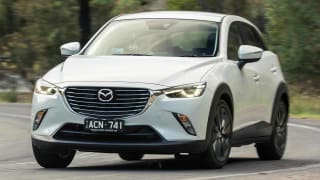
Mazda CX-3 Touring petrol 2015 review
Derek Ogden road tests and reviews the Mazda CX-3 with specs, fuel consumption and verdict.
Browse over 9,000 car reviews
Airbumps on doors don't soften the price blow of the style-driven Cactus.
Citroen's Cactus is designed to stand out in a crowd. With side panel inserts that resemble a giant pharmaceutical blister pack, it turns heads wherever it goes. The glances are generally more quizzical than admiring but it sure attracts attention.
Citroen calls the panels airbumps and claims they resist dents from errant shopping trolleys. Those who like them think that's cute and clever; those who don't think it's a high price to pay to guard against a potential panel-beating bill.
Standing out can be a good and bad thing in Australia's new-car market.
You can choose the colour of your bumps, side mirrors, roof pillars, roof bars and cabin trim — for a price
The quirky styling is likely to confine the Cactus to niche status, as the average Australian buyer isn't a risk taker — our top sellers are as conventional as we are conservative. And looks aren't the only stumbling block for potential buyers — there's no petrol automatic.
In the booming mini-SUV market there is probably room for Cactus to make a statement and a profit alike, although a $26,990 starting price is ambitious for a newcomer in a cut-throat market.
The Cactus approach to styling mimics the Mini, with myriad options to make your car look like nothing else on the road. There are 23,184 colour and trim combinations. You can choose the colour of your bumps, side mirrors, roof pillars, roof bars and cabin trim — for a price.
White paint is standard but choose anything more adventurous, say Hello Yellow or Deep Purple, and it adds $800. Blanc Nacre (French for premium white) is $1000.
Airbumps apart, the Citroen is a good-looking car, with a side profile reminiscent of a Mini and a front end that looks both stylish and sporty. Puffed out guards and scuff plates are a nod to off-road adventure.
Inside, the Cactus dash looks modern and streamlined. The jury is out on whether the touchscreen controls and digital instruments are more practical than conventional layouts.
There's no analog speedo or tacho and in the manual, the driver relies on gearshift lights for changing gears. If you're in third and the optimum gear is fourth, a little "4" with an arrow lights up on the instrument panel. The rest of the trip information is on a tablet-like screen that sits proud in the middle of the dash.
There are no buttons for the aircon, which means you have to scroll through menus to adjust the temperature. It's a bit fiddly. The rest of the menus are easy to find, though, and the layout is more logical than in French cars of the past.
Headroom is good in the front and the designers have liberated more legroom for the front passenger by deploying the passenger airbag from the roof instead of the dash. There are plenty of cubbyholes and a reasonably generous luggage area but no useful cupholders.
Rear passengers won't enjoy the pop-out windows and taller occupants will lack legroom.
Despite the off-road looks, the Cactus is well-suited to city life. Small and nimble, it's easy to park and light on the fuel around town, thanks to an engine that shuts itself down at the lights — we managed 8.0L/100km without trying in heavy city traffic.
The little three-cylinder turbo punches above its weight, pulling strongly both off the mark and in gear, making it easy to keep up with the traffic despite its modest 81kW.
Despite the premium price, there isn't much in the way of driver assistance. Similarly priced rivals have automated emergency braking, blind spot monitors and rear cross traffic alert as standard or optional.
In a world of vanilla alternatives, the Citroen is a breath of fresh air
The Cactus's only driver aids are a rear camera and parking sensors. Rear vision isn't great either, with a thick roof pillar blocking the view during merging. There are seat belt reminders for all five seats, though.
Occupants fare better for creature comforts, with climate control aircon, satnav, a big glove box and auto wipers and headlights.
The little Citroen is fun to drive. The steering feels sharp and it corners with more precision than you'd expect from an SUV, even one of this size.
It also feels stable at speed on the freeway — you don't feel as if you're driving a small, tinny buzzbox. An extra gear in the five-speed manual would make freeway cruising more relaxed but overall there's little to complain about.
The suspension can struggle to soak up some bumps, though, and there's some road noise on coarse-chip road surfaces.
On the freeway it's easy to hover near the claimed fuel consumption of 4.7L/100km. Premium fuel is required.
In a world of vanilla alternatives, the Citroen is a breath of fresh air. But the heart would have to rule the head to overcome the lack of an auto, premium price tag and four-star crash rating.
Satnav, "airbumps", reversing camera and sensors, climate control aircon, seat belt reminders all-round, auto wipers and headlights, start-stop engine tech.
Front parking sensors, automatic option, blind spot monitor, auto emergency braking, auto rear windows, rear air vents.
Citroen's warranty is among the longest: six years/unlimited km. Six years of capped servicing costs $3270, which is a little steep given service intervals are 12 months apart.
| Vehicle | Specs | Price* | |
|---|---|---|---|
| Exclusive 1.6 E-HDi | 1.6L, Diesel, 6 SP | $16,170 – 20,790 | 2016 Citroen C4 Cactus 2016 Exclusive 1.6 E-HDi Pricing and Specs |
| Exclusive 1.2i Puretech | 1.2L, ULP, 5 SP MAN | $11,110 – 15,180 | 2016 Citroen C4 Cactus 2016 Exclusive 1.2i Puretech Pricing and Specs |
$9,990
Lowest price, based on 2 car listings in the last 6 months